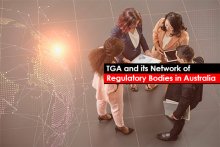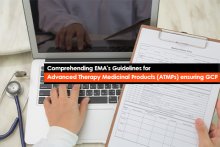Regulatory Guidelines for the Pharma Industry, so far in ‘16
In an ever changing world of Life Sciences regulations, the Pharma industry has seen many new mandatory requirements from the health authorities worldwide. Right from the Food and Drug Administration (FDA), European Medicines Agency (EMA), Therapeutic Goods Administration (TGA), the Health Canada (HC), the Saudi Food and Drug Authority, to the Medicines Control Council, health authorities worldwide have released numerous guidelines and guidance documents, if not mandates related to stringent deadlines to be followed for Regulatory Submissions and Publishing, Labeling, Cosmetics, Medical Devices and for many more categories. As we come near to the end of the year 2016, we would like to give you a throwback on Regulatory guidelines for the Pharma industry in general.
Submissions & Publishing
Mandatory ‘non-eCTD electronic only’ DMF submissions towards Health Canada
After an announcement by Health Canada, all existing Drug Master Files (DMF) in paper format are being converted to “non-eCTD electronic-only” format to comply with the March 31, 2016 deadline. Electronic documents are expected to be uploaded onto the Health Canada viewing tool, where they would be accessible instantly to Health Canada staff involved in the review of the regulatory activities. In case a company couldn’t manage to provide the complete electronic copy of the DMF, it would get suspended, i.e., no further access for review will be granted and no update will be accepted for the DMF.
The main focus and intention of mandatory DMF conversion is to encourage overall effective record management and to ensure authenticity, integrity, availability, traceability, and non-repudiation of the data is maintained.
Baseline towards SFDA optional for products that finished all regulatory activities
The Saudi Food and Drug Authority (SFDA) updated its Baseline eCTD Submission Requirements, which stressed that, effective from 17th of July 2016 onwards, baseline would be optional for products that finished all regulatory activities (initial registration, renewal or variation etc.).
However, it should be noted that come 1st of January 2017, the baseline will be mandatory for any new regulatory activities such as initial registration, renewal or variation etc.
Regulating complementary medicines in South Africa post June 2016 requires dossier submissions in ZA CTD (South Africa Common Technical Document) format.
Just like every country has its own Regulatory data requirements when it comes to dossier submissions for medicine registrations, the South African market has a specific format as well. Post June 2016, regulating complementary medicines in South Africa requires dossier submissions in a ZA CTD (South Africa Common Technical Document) format.
Aimed at harmonization of the overall dossier content, the ZA CTD submission seemed to be quite a daunting task for companies to chalk out special plans and executing procedures for the CTD conversions.
EMA encourages companies to submit Type I variations for 2016 by end of November
The European Medicines Agency (EMA) advised marketing authorisation holders to submit any Type IAIN and Type IA variations for 2016 by end of November. This will in turn enable the Agency to acknowledge the validity of the submissions before the Agency’s closure between 23rd December 2016 and 2nd January 2017 within the 30-day timeframe set out in Article 14 of Commission Regulation (EC) No 1234/2008.
Marketing authorisation holders are also advised to submit any Type IB variations or groupings of Type IB and Type IA variations to initiate procedures in 2016 by 13th December 2016. For submissions received on or after 14th December 2016, the procedure may not start until January 2017.
Cosmetics
The Food and Drug Administration (FDA) has established that the antiseptic wash products with certain (19 in number) active ingredients can no longer be marketed.
In a September 2016 announcement, the Food and Drug Administration (FDA) has established that the antiseptic wash products with certain (19 in number) active ingredients can no longer be marketed. As per the final rule released by the FDA, manufacturers marketing OTC antibacterial soaps are required to remove active ingredients: Triclocarban and Triclosan from their products. However, the guidance is not applicable to products like wipes, hand sanitizers, shaving creams, or toothpastes.
As of now, the manufacturers got one-year timeframe to have these ingredients removed from their products and comply with the guidance. Until then, these products cannot be marketed so need to be recalled or reformulated to abide by the guidance.
Japan implements the Ingredient ban for Medicated Products
Following the US Food and Drug Administration’s (FDA) announcement of the final safety rule for antibacterial soaps, Japan turned the first implementation force in APAC announcing (in October 2016) that they have implemented the ingredient ban already.
The Japanese Ministry of Health, Labour, and Welfare (MHLW) informed that they have eliminated the suggested ingredients from medicated products such as soaps, hand wash, shower gel and facial cleansing.
With the reports stating that Triclosan and Triclocarban are the two commonly used ingredients across the Asia-Pacific region and world over, Japan’s immediate implementation makes a welcoming gesture for other countries to follow the suit at the earliest.
Cosmetics Notifications System in Malaysia
The cosmetic notification system in Malaysia has been active for quite some time now. For a company to be able to market their products in Malaysia, it needs to notify the Director of Pharmaceutical Services (DPS) through the National Pharmaceutical Control Bureau (NPCB). It is made obligatory for the companies to be first registered with Syarikat Suruhanjaya Malaysia (SSM) or Malaysian Registrar of Business (ROB). Malaysia seems to be one of the most promising emergent markets, especially for cosmetic product manufacturers. Missing out an opportunity to register cosmetic product through Malaysian cosmetic notification system may result in loss of great opportunities.
Labeling
Health Canada releases plain language labeling guidance. For prescription products and those administered or obtained through a health professional, the Regulations apply as of June 13, 2015.
To prevent drug adverse events, Health Canada released a guidance document for Plain Language Labeling, which came into effect from June 13, 2015, for Prescription drugs, and is expected to come into effect from June 13, 2017, for non-prescription drugs.
The motto behind the frequent labeling guidelines is to ensure that labels not only convey accurate drug information to the end user, but also ensure drug safety by making the information easy to understand by both physicians and patients alike.
Starting 31st August 2016, TGA introduced new labeling rules and gave a four-year extension for medicine manufacturers to update their labels.
New labeling requirements announced by the Therapeutic Goods Administration (TGA) went effective from 31st August 2016 and a four-year transition time has been given to companies to be compliant with the improved standards. The sponsors will have enough time for transition and from 1 September 2020, their medicine labels will need to comply with the new improved regulations.
The new standards will be available on the Federal Register of Legislation on 17th August 2016, thus making it an easy process for the Sponsors to review them before they come into effect.
Medical Devices
The UDI and the postponed mandate. Compliance date extended for UDI label and data submission requirements to September 24, 2018, for certain class II devices
In a September 6, 2016 released announcement, the Food and Drug Administration has informed labelers that compliance date for certain class II devices is extended to September 24, 2018 and clarified that the same date will act as compliance date for device constituents of certain combination products UDI label and GUDID submission requirements.
In General
MHRA no longer wants GPvP compliance reports to be submitted
The United Kingdom’s Medicines and Healthcare Products Regulatory Agency (MHRA) has on, 25th July 2016, updated that it no longer wants GPvP compliance reports to be submitted by organizations.
Though the agency has dropped the requirement of GPvP compliance reports, it may contact organizations at any given time for necessary information about the pharmacovigilance systems and authorized products. So, it is still an obligation for companies to maintain or follow the Good Pharmacovigilance Practices which are going to be useful, when necessary.
The Brexit and aftermath
As Britain voted to leave the European Union (EU) on June 23, 2016, the situation seems to be uncertain for drug/pharmaceutical companies to plan with the regulatory processes. The first and foremost would be the impact of Health Authorities relocation. As the UK decided to move on from the EU, Britain could face uncertainties right from manufacturing, testing, and release of medicines into the market and to conduct clinical trials outside the UK, approaching for health authority inspections, understanding the patents ecosystem, and obtaining product licenses.
On the other hand, it could even be a severe setback to EU’s drug / medicines approval processes as the industry anticipates that the Brexit could snarl the regulatory system and create uncertainty among operational procedures at the EMA which might result in complexities and confusion soon. Whatever may be the implications, navigating through the regulatory ecosystem in the UK and the EU regions in the current uncertain scenarios might be like wading through the unknown waters for the manufacturers who are new to the market.
In conclusion, it’s not how the industry is being regulated, but how the Pharma manufacturers or companies are sustaining the change/transition that matters when it comes to end-to-end compliance. Given the region-specific procedural complexities that manufacturers face to bring their products to market, their invaluable Regulatory efforts and audit- and compliant- ready procedures should take the centre stage. Freyr is delighted to be taken part in doing so for the year 2016 for some of the global Bio-Pharma (Innovators / Generics), Consumer Healthcare and Medical Device companies. Know more on www.freyrsolutions.com
References:
https://www.gov.uk/guidance/good-pharmacovigilance-practice-gpvp#history





